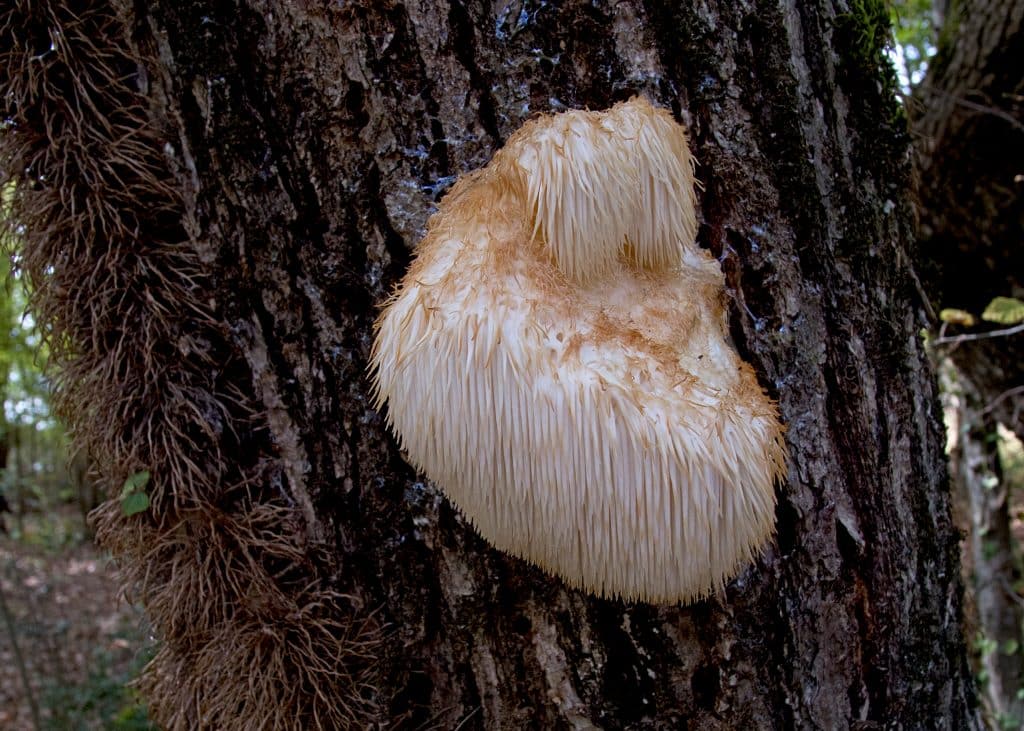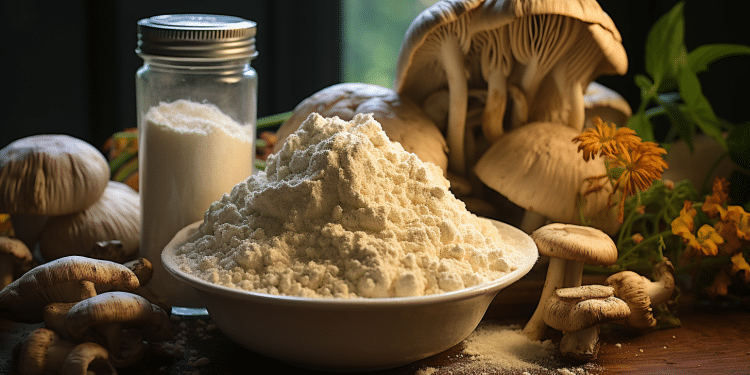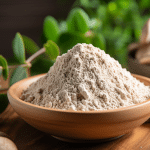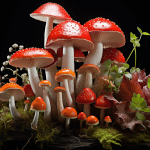Consumers seeking the cognitive and health benefits of Lion’s Mane mushrooms often grapple with the best methods for incorporating it into their regimen. Understanding how to take lions mane mushroom effectively is essential, as its therapeutic potential hinges on proper usage. They must consider dosage, form whether extract, powder, or capsule—and timing to optimize its impact on brain health and immune function. This post aims to guide consumers through these critical decisions with clarity and evidence-based recommendations, ensuring they can leverage the full spectrum of this natural nootropic’s capabilities.
Lion’s Mane Mushroom Powder Usage Guide
Consumers can easily integrate Lion’s Mane mushroom powder into their daily routine. By adding the powder to various foods and drinks, they reap potential health benefits. It is versatile and can be incorporated without much hassle.
One popular method is mixing the powder into a morning smoothie or coffee. This does not significantly alter the taste of the beverage but adds nutritional value. For example, someone might blend a teaspoon of Lion’s Mane with their favourite fruits, yogurt, and a splash of juice for a nutritious start to the day. Similarly, stirring it into coffee creates an enhanced drink that may support cognitive function throughout the day.
Another simple way to consume this supplement is by making tea. Here are easy steps:
-
Measure out one teaspoon of mushroom powder:
-
Mix it with hot water in a cup;
-
Stir until fully dissolved;
-
Enjoy as is or sweeten as desired.
Apart from beverages, Lion’s Mane mushroom powder also finds its place in culinary practices:
-
Sprinkle over salads for an earthy flavour boost;
-
Incorporate into soups or broths; it blends well with liquid-based recipes;
-
Use seasoning on vegetables before roasting them in the oven.
Each addition ensures consumers receive extra nutrients from their meals while enjoying new flavours introduced by this functional food ingredient.
Determining the Ideal Lion’s Mane Powder Dosage
When consumers decide to incorporate how to take lions mane mushroom into their regimen, they often begin by following the manufacturer’s recommended serving size. This is a crucial first step as it provides a baseline dosage that has been deemed safe and effective for general use. Manufacturers take into account various factors when determining this dosage, including average body weight and intended health benefits.
However, individuals are unique in terms of body composition and health objectives. Therefore, it may be necessary for them to adjust the amount of lion’s mane powder they consume. They should consider their own body weight when dosing; someone with a larger physique may require more of the supplement compared to someone who is lighter. Similarly, specific health goals, such as cognitive enhancement or nerve regeneration support, could influence how much one should take.
In addition to these considerations, consumers must pay attention to how their bodies respond after taking lion’s mane mushroom powder. Personal tolerance can vary greatly among individuals. Some might experience optimal benefits at a lower dose, while others may find they need more than what is suggested on the packaging.
How to Take Lions Mane Mushroom Optimal Timing
Once consumers have determined the ideal dosage of how to take lions mane mushroom powder, they face another important consideration: when to take it. Timing can play a crucial role in maximizing the benefits of this natural supplement. Taking lion’s mane mushroom in the morning may enhance cognitive function throughout the day. This is due to its potential nootropic effects that could improve mental clarity and focus.
For those looking to boost their productivity during study or work sessions, consuming lion’s mane beforehand might provide an improvement in concentration. It acts as a catalyst for mental alertness which can be particularly beneficial before engaging in tasks that require intense focus.
In contrast, evening consumption of lion’s mane mushroom has been suggested by some as a means to support restful sleep. The reasoning behind this lies in its content of nerve growth factors which are believed to aid brain health and relaxation. However, since individual responses can vary, consumers should monitor how taking it at different times affects them personally.
Exploring Different Methods of Taking Lion’s Mane Powder
Consumers seeking the cognitive and neurological benefits of how to take lions mane mushroom have various methods at their disposal for incorporating this supplement into their diet. One popular method is to encapsulate the powder. This allows for convenience and ensures a controlled dosage with each use. Capsules can be purchased pre-made from suppliers, or individuals can make their own using empty capsules available in stores.
Another way to consume lion’s mane powder is by blending it into beverages. For those who maintain an active lifestyle, adding the powder to a protein shake or meal replacement drink provides not only the desired compounds from the mushroom but also fits seamlessly into their daily routine. The taste of lion’s mane is subtle and can easily complement other flavours in these types of beverages. Baking offers an alternative method that infuses nutritional value into everyday snacks and meals. The versatile nature of lion’s mane powder means it can be added as a filler – without acting as unnecessary bulk – in goods like muffins or energy bars. When baked, the heat does not significantly affect its beneficial properties, making it an effective way to consume this adaptogen.
In addition to these ways, some consumers may prefer simply stirring lion’s mane powder into hot water to create a tea-like beverage—though this method might not appeal to everyone due to its earthy flavour profile:
-
Encapsulating for controlled doses;
-
Blending into shakes for convenience;
-
Baking into foods as an edible option.
These options provide flexibility when integrating how to take Lion’s Mane mushroom into one’s diet while ensuring that they do not miss out on any potential health benefits associated with its consumption. While considering these methods, consumers should also be mindful of any fillers or additional ingredients present in products sourced from suppliers. Pure forms are often more desirable than those with lots of additives which could dilute efficacy.

Unveiling the Health Benefits of Lion’s Mane Mushroom
Consumers seeking cognitive enhancements may find how to take lions mane mushroom beneficial. Research suggests it could boost memory and brain function. This is attributed to compounds that stimulate the growth of brain cells. People incorporate lion’s mane into their diets, hoping to sharpen their minds.
This mushroom species, Hericium erinaceus, is also known for supporting immune health. It contains beta-glucans, which are sugars found in the cell walls of bacteria, fungi, yeasts, algae, lichens, and plants such as oats and barley. Beta-glucans are believed to strengthen immunity against illnesses. Another potential benefit lies in digestive health. Lion’s mane can foster a balance among gut bacteria which is crucial for digestion. A healthy gut flora not only aids food breakdown but also impacts overall well-being.
Understanding the Neuroprotective Effects of Lion’s Mane Mushroom
How to take lions mane mushroom contains bioactive substances that may significantly benefit brain health. These substances have been shown to promote nerve growth factor (NGF) synthesis, a protein crucial for the survival and function of neurons. By increasing NGF levels in the body, consumers might experience enhanced cognitive function and a lower risk of developing neurodegenerative diseases.
Research indicates that lion’s mane can potentially slow or reverse cell degeneration in the brain, which is pivotal in diseases like Alzheimer’s. This could be life-changing for individuals at risk or already facing such conditions. The mushroom’s compounds support overall nervous system health by fostering new connections and repairing damaged ones.
In cases of nervous system injuries, lion’s mane has demonstrated promising effects on recovery speeds. It supports nerve regeneration, meaning it may help nerves repair themselves after injury more quickly than they would otherwise. This property not only benefits those with physical nerve damage but also aids individuals recovering from neurological traumas:
-
Consumers looking to enhance their cognitive abilities find lion’s mane an attractive option;
-
Those concerned about neurodegenerative diseases see potential preventive benefits;
-
Individuals recovering from nervous system injuries may experience accelerated healing.
The immune system also plays a role in neural protection and repair; thus, supporting it is vital for maintaining optimal brain functionality. Lion’s mane contributes to this by bolstering the immune defense against pathogens that might otherwise harm neuronal integrity.
Investigating the Cardiovascular Benefits of Lion’s Mane Mushroom
How to take lions mane mushroom has caught the attention of researchers for its potential cardiovascular benefits. Studies suggest it may help lower bad cholesterol levels. This reduction could decrease the risk of heart disease, a leading cause of death worldwide. The mushroom contains bioactive compounds that seem to be at work here. Animal research provides evidence supporting these claims. For example, in studies involving mice, Lion’s Mane consumption led to a decline in LDL cholesterol levels—often referred to as “bad” cholesterol. High levels of LDL can lead to plaque buildup in arteries and result in heart conditions.
The mushroom may also improve blood circulation and overall cardiovascular health. Good circulation is vital for delivering nutrients and oxygen throughout the body. It helps keep organs functioning properly. Antioxidants found in Lion’s Mane could prevent arterial damage by combating oxidative stress within the body’s system. Oxidative stress occurs when there’s an imbalance between free radicals and antioxidants in your body, potentially leading to cell damage.
By understanding both the how to take lions mane mushroom neuroprotective effects previously discussed and exploring cardiovascular advantages here, it becomes clear that it holds multifaceted potential for enhancing well-being. The promise seen through initial studies ignites interest among scientists and consumers alike who seek natural remedies supported by scientific evidence. As further research unfolds, clearer guidelines on how best to take advantage of this unique fungus will emerge.
Addressing Safety and Side Effects of Lion’s Mane Consumption
When considering the addition of lion’s mane mushroom to a health regimen, safety is paramount. Lion’s mane is generally well-tolerated, with most consumers experiencing no adverse effects. Research indicates its use comes with minimal risk. However, as with any supplement, understanding potential side effects ensures informed decisions. Some individuals may experience mild digestive upset when consuming lion’s mane, especially in large doses. This can include symptoms such as bloating or discomfort. To minimize this risk, it is advisable to start with smaller amounts and gradually increase the dosage over time.
Final Remarks
Consumers seeking to harness the cognitive and cardiovascular benefits of how to take lions mane mushroom have a variety of consumption methods at their disposal. This article has provided a comprehensive guide on the optimal usage, dosage, and timing for taking powder. It has also illuminated the significant health benefits and neuroprotective effects of this functional food while addressing safety considerations and potential side effects. The knowledge imparted aims to empower individuals with the information necessary to integrate Lion’s Mane into their wellness regimen effectively.
Reference:
Hericium erinaceus (Bull.: Fr.) Pers., a medicinal mushroom, activates peripheral nerve regeneration
Learn More:
Mushroom Grow Bags | A Quick Walkthrough of Things to Know
How to Tell if Mushrooms Are Bad: The Obvious and Not-So Obvious Signs















